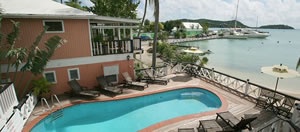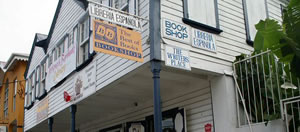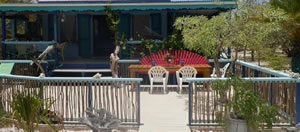Aruba
Aruba is a Caribbean island 15 miles north of the coast of Venezuela, an autonomous dependency of the Kingdom of the Netherlands. It is 30 km (19.6 miles) long and 9 km (6 miles) across at its widest point giving it an area of approximately 70 mi (184 km). This flat island with no rivers is renowned for its white sand beaches and tropical climate moderated by constant trade winds from the Atlantic Ocean. The temperature is almost constant at about 27C (81F) and the yearly rainfall usually does not exceed 20 inches. Aruba lies outside the Caribbean hurricane belt.
Aruba is divided into the north-east and south-west coasts. The south-west has the white sand beaches, turquoise seas, and warm waters. The north-east coast, exposed to the Atlantic, has a few white sand beaches, cacti, rough seas with treacherous currents, and a rocky coastline. The time in Aruba is Atlantic Standard Time; it is the same as Eastern Daylight Savings Time all year round.
Climate
The climate is tropical marine, with little seasonal temperature variation. Because of its location south in the Caribbean there is very strong sun, but a constant light breeze keeps the "feel-like" temperature pleasant. These persistent winds out of the east shape the island's distinctive, lop-sided divi-divi trees. The trees have become a signature tree to Aruba's landscape. The weather is almost always dry, with most rain showers coming at night and lasting only a little while. Temperatures in Aruba do not change dramatically. Between the months of January and March the temperatures stay around 76-85 degrees; this being their high season. However April and through December is considered off season and temperatures do not change much beyond 79 and 88 degrees.
Landscape
The island is flat with a few hills, arid with mostly desert vegetation and negligible natural resources other than white sandy beaches. Highest point: Mount Jamanota (188 m).
History
Discovered and claimed for Spain in 1499, Aruba was acquired by the Dutch in 1636. The island's economy has been dominated by three main industries. A 19th century gold rush was followed by prosperity brought on by the opening in 1924 of an oil refinery. The last decades of the 20th century saw a boom in the tourism industry. Aruba seceeded from the Netherlands Antilles (Bonaire and Curacao, the ABC-Islands) in 1986 and became a separate, autonomous member of the Kingdom of the Netherlands. Movement toward full independence was halted at Aruba's request in 1990.
Tourism is the mainstay of the small, open Aruban economy, with offshore banking and oil refining and storage also important. The rapid growth of the tourism sector over the last decade has resulted in a substantial expansion of other activities. Construction has boomed, with hotel capacity five times the 1985 level.
Symbolism
Papiamento and the national flag, anthem, and coat of arms are the most important national symbols. They stress the inhabitants' love for the island, the close connection to the Caribbean Sea, and the multi-cultural composition of the population. The national anthem is played and sung on many occasions. The Dutch flag functions as a symbol of the unity of Aruba, the Netherlands, and the Netherlands Antilles.
Etiquette
You should not wear beach attire anywhere but on the beaches or at the pool.
Make sure to properly greet someone.
Ask before photographing someone.
Men should wear dress shorts or slacks to dinner, no jeans allowed in most restaurants.
Electricity
Officially 120V 60Hz, which is identical to the US and Canadian standard. Outlets are North American grounded outlets, identical to standard US and Canadian wall outlets. Occasionally non-grounded outlets may be found, which do not accept the third, round pin present on grounded plugs and require an adapter. Older North American outlets may not be polarized (with one slot wider than the other). Otherwise, adapters are available which accept a polarized plug and adapt it for use with a non-polarized outlet.
Food and Drink
Aruba's tap water is produced at the largest and most modern purification plant in the Caribbean and is considered safe to drink. Milk is pasteurised and dairy products are safe for consumption. Local meat, poultry, seafood, fruit and vegetables are available at several large supermarkets and is generally considered safe to eat.
Currency & Money
Aruba's currency is the florin denoted by the letters "Awg." but also widely known as "Afl." (Aruban florin). The official rate at which banks accept U.S. dollar banknotes is Awg. 1.77 and checks at Awg. 1.78. The rate of exchange granted by shops and hotels ranges from Awg. 1.75 to Awg. 1.80 per U.S. dollar. U.S. Dollars are widely accepted in Aruba, and banks may exchange other foreign currency. Traveler's checks are widely accepted and there is no charge for using them in hotels, restaurants and stores. Major credit cards are accepted at most establishments while personal checks are normally not accepted.
Cash may be obtained with MasterCard, Visa and American Express cards at credit card offices, banks, in some casinos and via Western Union. ATM cards and credit cards are accepted by ATMs of Aruba Bank, Banco di Caribe, RBTT Bank, and Caribbean Mercantile Bank. The card must have either a Cirrus or Visa Plus logo. ATM instructions are normally given in Dutch, English, Spanish and Papiamento. Cash is normally dispensed in local currency.




















